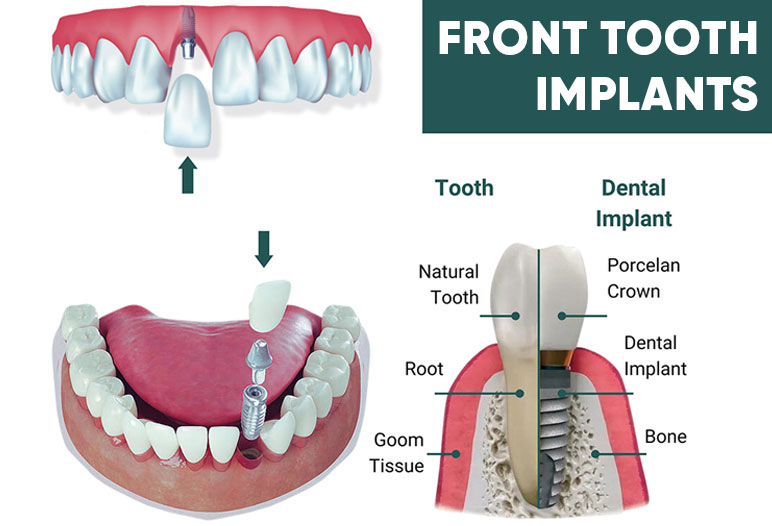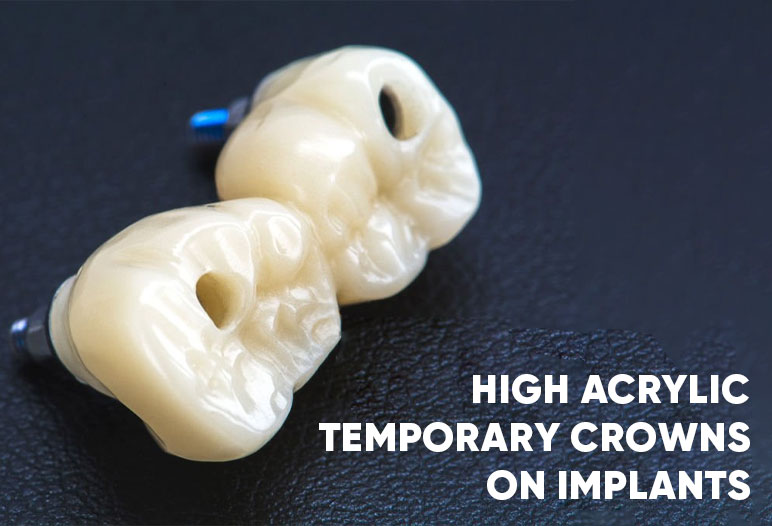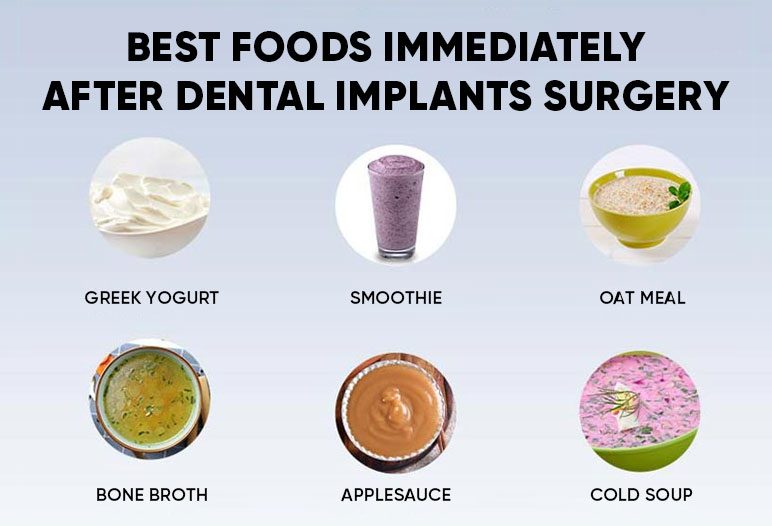A temporary implant crown serves as a crucial component in the process of getting dental implants. It acts as a placeholder while providing necessary support to your teeth and maintaining aesthetics during the healing period. Understanding how long these crowns last, their purpose, and the care needed for them is essential for anyone undergoing this dental procedure.
What is a Temporary Implant Crown?
A temporary implant crown is a prosthetic that is placed on top of an implant before the permanent crown is installed. Its primary purpose is to protect the implant site while allowing the surrounding tissues to heal properly post-surgery. This type of crown helps in maintaining the function and appearance of teeth during the transitional phase.
The process begins with the placement of a dental implant into the jawbone, which serves as the root for the new tooth. After healing, an abutment is attached to the implant; this is where the temporary crown sits. The placement of a crown is typically done several weeks after the abutment installation, and thus there exists a time between abutment and crown which varies based on individual healing rates.
In cases involving a front tooth implant temporary, aesthetics play a significant role due to its visibility. Patients often express concerns about the look of their temporary crowns, wanting something that closely resembles natural teeth. This concern highlights the need for well-constructed temporary crowns, providing both functionality and visual appeal during the waiting phase for the final restoration.

Temporary crowns provide not only immediate cosmetic benefits but also functional stability. They enable patients to chew and maintain everyday activities without discomfort, promoting better oral hygiene and health overall.
Moreover, they help preserve the shape of the gums around the implant site, preventing any potential gum recession or changes in appearance. By keeping the area occupied until the permanent crown is ready, temporary crowns make sure that the patient’s smile remains intact during the entire process.
Importance of Temporary Crowns
Temporary crowns are pivotal in the overall success of dental implant procedures, serving multiple functions that extend beyond mere aesthetics. Their significance can be illustrated through a deeper understanding of their roles, benefits, and the psychological comfort they provide to patients.
Supporting Healing
After a dental implant is placed, the surrounding tissues require time to heal and integrate with the implant securely. A dental implant temporary crown helps facilitate this healing process by absorbing occlusal forces and distributing pressure evenly across the jaw.
This even distribution is essential because it enables the bone to adapt and fuse with the titanium implant without undue stress. An improperly fitted temporary could lead to complications such as inflammation or infection, thus elongating the healing period or jeopardizing the implant’s success.
Aesthetic Considerations
For many patients, especially those receiving a front tooth implant temporary, aesthetics are paramount. A temporary crown offers a solution that allows individuals to maintain their self-esteem and confidence while awaiting the final restoration.
It can be particularly distressing to have a gap in one’s smile, leading to social anxiety. Temporary crowns alleviate these concerns by mimicking the shape, size, and color of natural teeth. Dentists strive to match temporary crowns as closely as possible to existing teeth, allowing patients to continue social interactions without feeling conscious about their appearance.
Psychological Comfort
The psychological aspect of wearing a temporary implant crown should not be overlooked. Having a solid, aesthetically pleasing placeholder can significantly enhance a patient’s mental state. The presence of a temporary crown assures patients that they are on the right track toward restoring their oral health.
Furthermore, knowing that they are actively participating in their treatment can empower individuals, making them feel more involved in the journey. Overall, the importance of temporary crowns extends beyond the physical realm; it encompasses emotional and psychological well-being as well.
Understanding Temporary Crowns
Temporary crowns are made from various materials and designed to fulfill specific purposes during the dental implant process. Understanding the materials and their respective pros and cons is vital for informed decision-making.
Materials Used
The fabrication of temporary crowns generally involves materials like acrylic and resin. Both materials exhibit distinct properties, advantages, and disadvantages that can affect their performance during the healing phase.
Acrylic Crowns
Acrylic temporary crowns are widely used because they are cost-effective and easy to manipulate. They can be adjusted chairside to fit each patient perfectly. However, one drawback is their tendency to wear down quicker than other materials, potentially requiring earlier replacement.
Furthermore, acrylic may not offer the same level of aesthetic appeal as more advanced materials. They might not blend seamlessly with natural teeth, which could impact patients who place a high value on appearance, especially for front tooth implant temporary crowns.

Resin Crowns
Resin composite crowns are another popular choice for temporary restorations. They tend to be more aesthetically pleasing, providing a closer match to natural tooth color and translucency. These crowns can withstand moderate chewing forces and maintain their integrity longer than acrylic options.
However, resin crowns may be more prone to chipping or cracking under excessive force and are typically less adjustable chairside than acrylic. Dental professionals often consider each patient’s lifestyle and needs when deciding on the appropriate material for a temporary crown.
Appearance and Function
The appearance and function of a temporary implant crown are crucial considerations for both dentists and patients. Temporary crowns must not only restore function but also visually mimic real teeth.
Visual Appeal
Temporary crowns should ideally match the shade and contour of existing teeth. Dentists take great care to ensure that these crowns do not draw attention for the wrong reasons. The goal is to create a seamless transition from the temporary to the permanent crown, allowing patients to maintain their smiles.
Functional Role
Functionally, temporary crowns serve to stabilize the surrounding gums and provide support while chewing. They allow individuals to eat soft foods comfortably, enabling normal eating habits while waiting for the final restoration. Maintaining oral function is essential during this transitional period, as improper chewing can lead to additional complications.
Moreover, a well-crafted temporary crown allows individuals to speak normally, preventing any speech impediments that may arise from tooth loss. It is imperative that patients view their temporary crowns as integral components of their overall dental health strategy.
Caring for Your Temporary Crown
Proper care and maintenance of a temporary implant crown are vital for its longevity and the success of the overall dental procedure. Patients must be educated on how to treat their temporary crowns to avoid issues that may prolong their treatment.
Eating and Chewing
Eating with a temporary crown requires some precautions to ensure it remains intact and functional. Specific instructions can help guide patients in taking care of their temporary crowns while still enjoying food.
Avoid Hard, Sticky, or Chewy Foods
One of the most critical guidelines is to avoid hard, sticky, or chewy foods. These types of foods can dislodge or damage a temporary crown, which can lead to unnecessary delays in treatment.
Patients should be cautious with items like nuts, popcorn, hard candies, or anything excessively chewy. Additionally, biting down on ice or using teeth to open packages can lead to disaster.

Chewing on the Opposite Side
To minimize the risk of damaging the temporary crown, patients should aim to chew on the opposite side of the mouth whenever possible. This simple adjustment can alleviate unnecessary pressure on the temporary crown, allowing it to remain stable throughout the healing phase.
By focusing on softer foods and utilizing the other side for chewing, individuals can maintain a semblance of normalcy during their treatment, ensuring both comfort and safety.
Oral Hygiene
Good oral hygiene is paramount for the longevity of a dental implant temporary crown. Patients must understand how to effectively clean the area surrounding their temporary crown to prevent plaque buildup and potential infections.
Brushing and Flossing
Brushing should continue as usual, with gentle strokes around the temporary crown. Special care should be taken not to apply too much pressure on the crown itself, as this may cause dislodgment.
Flossing requires a bit more attention. Patients should use waxed floss to avoid snagging on the temporary crown. Careful insertion and removal of floss will help maintain the integrity of the crown while ensuring that the gum line remains healthy.
Use of Mouthwash
Incorporating an antimicrobial mouthwash into daily hygiene routines can further promote oral health. This practice can help reduce bacteria levels and minimize the risk of infection during the healing process.
Caring for a temporary crown may require slight adjustments to daily habits, but these efforts yield significant rewards in maintaining oral health and supporting the overall success of the dental implant.
Conclusion
In summary, a temporary implant crown plays a pivotal role in the journey to achieving a successful dental implant restoration. Understanding its purpose, types of materials used, and the importance of care and maintenance can significantly enhance the experience for patients.
From supporting healing and aesthetics to alleviating psychological discomfort, temporary crowns serve multifaceted roles throughout the transitional phase. Proper care, such as mindful eating habits and diligent oral hygiene, can extend the life of these crowns, ultimately paving the way for a smooth transition to permanent restorations.
As you embark on your dental implant journey, remember that the temporary crown is not just a placeholder; it contributes significantly to your oral health and confidence. Embrace this phase of your treatment, and look forward to the beautiful results ahead!

 Google Reviews
Google Reviews Call
Call
SAIGON IMPLANT CENTER
Best dentist in Vietnam
Saigon Implant Center - Dental Clinic utilizes the latest technology for specialized treatment in the field of Single implant, full jaw implants, All on 4 implants, All on 6 implants, Zygoma implant....
SAIGON IMPLANT CENTER
Best dentist in Vietnam
Saigon Implant Center - Dental Clinic utilizes the latest technology for specialized treatment in the field of Single implant, full jaw implants, All on 4 implants, All on 6 implants, Zygoma implant....